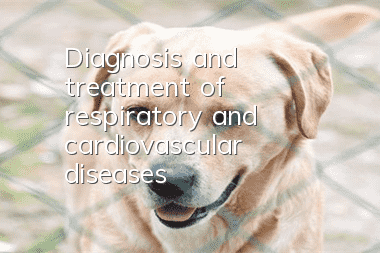Diagnosis and treatment of respiratory and cardiovascular diseases

Laryngitis
Definition
●Inflammation of laryngeal mucosa and submucosa tissues
●Clinically, severe cough, throat sensitivity, and swelling are the main symptoms
●Divided into two types: catarrhal and fibrinous
Cause
●Physical factors
--Cold stimulation
--Injury from foreign objects, such as bones, needles, pins and external stimulation
--Warm stimulation
--Excessive screaming
●Chemical factors
--Volatile chemical raw materials
--Exhaust gas from feedlots
--Spraying and using high-concentration disinfectants, etc.
●Biological factors: Certain viral or bacterial infections, such as canine distemper virus, feline rhinotracheitis virus, Staphylococcus, Streptococcus and other infections
●Other factors: spread of inflammation in adjacent organs
Symptoms
●Acute laryngitis
--The main manifestation is cough. The sick dogs and cats bark hoarsely or can't bark at all, and their expressions are extremely painful. At the beginning of the disease, a rough, short and powerful painful dry cough can be heard, which turns to a soft wet cough in the later stage.
--The throat is highly sensitive to palpation, coughing occurs, and vomiting often occurs after coughing
--Laryngeal stenosis sound can be heard during laryngeal auscultation
--In mild cases, there are no obvious systemic symptoms
--In severe cases, the body temperature rises, the spirit becomes depressed, the lymph nodes near the throat are swollen, and the head is unwilling to move
--When laryngeal edema occurs, sick dogs and cats will have inspiratory difficulty breathing and open their mouths to breathe. In severe cases, they may suffocate and die
●Chronic laryngitis
--Generally there are no obvious symptoms, only frequent coughing in the morning and sensitivity to palpation of the throat
--The laryngeal mucosa is thickened, swollen in a granular or nodular shape, connective tissue hyperplasia, and the laryngeal cavity is narrowed
Laryngoscopy
●Gently anesthetize the animal and then conduct an examination
--Check the surfaces on both sides of the vocal cords and the left and right pyriform sinuses, lateral ventricular vocal cords, sublingual, larynx and other parts, focusing on observing their shape, color and movement.
Diagnosis
●Diagnosis can be based on clinical symptoms such as cough and throat sensitivity, combined with laryngoscopy
●Note the difference from rhinitis, pharyngitis and bronchitis
--Rhinitis: Increased nasal fluid makes it more difficult to inhale, but generally no cough
--Pharyngitis: mainly characterized by dysphagia and mild cough
--Bronchitis: The larynx is not sensitive, there is no simple difficulty in breathing, and the cough is not as severe as laryngitis
Treatment
●Remove the cause of the disease, place the sick dog and cat in a warm, clean environment, and feed them liquid or soft food
●Antitussive, expectorant, and analgesic
--For dry cough, codeine phosphate: 1.1-2.2 mg/kg.w for dogs, 3-4 times/day, subcutaneous injection; cats 0.25-4 mg/kg.w, orally, 1-2 times a day. Urgent branch syrup: 20 ml each time, orally, 3 times a day. Compound licorice tablets, 1 to 2 tablets, 3 times a day
--It is not advisable to use cough medicine for wet cough. When there is a lot of phlegm, you can take ammonium chloride orally, 0.1-0.2g each time, once a day
Treatment
●Antibacterial and anti-inflammatory
--Intramuscular injection of penicillin, 800,000 IU/time, 2 times/day
--When the cough is severe, 2ml of 1% procaine and 200,000 IU of penicillin can be mixed and injected into the throat to seal the throat, twice a day, alternating between the left and right sides
●Physical therapy: In the early stage of the disease, ice packs can be used to apply cold compresses to the throat to constrict blood vessels and reduce laryngeal edema. Later, hot compresses can be used to promote the resolution of inflammation
●Tracheotomy can be performed when the laryngeal obstruction is severe and causes difficulty in breathing.
- What is the reason why Alaskan dogs stagger when walking? A must-read for pet owners!
- What are the symptoms of anorexia in dogs?
- How to apply for a dog breeding license? What are the requirements for applying for a dog ownership license?
- How to brush your dog’s teeth
- How to train a dog to refuse food from strangers
- Are field terriers highly intelligent and are they easy to raise_Pictures|Training
- What foods can Tibetan Mastiffs not eat?
- Dog body care schedule
- How to train a dog to adapt to the environment?
- How to judge whether a Great Pyrenees dog has an excellent personality?



